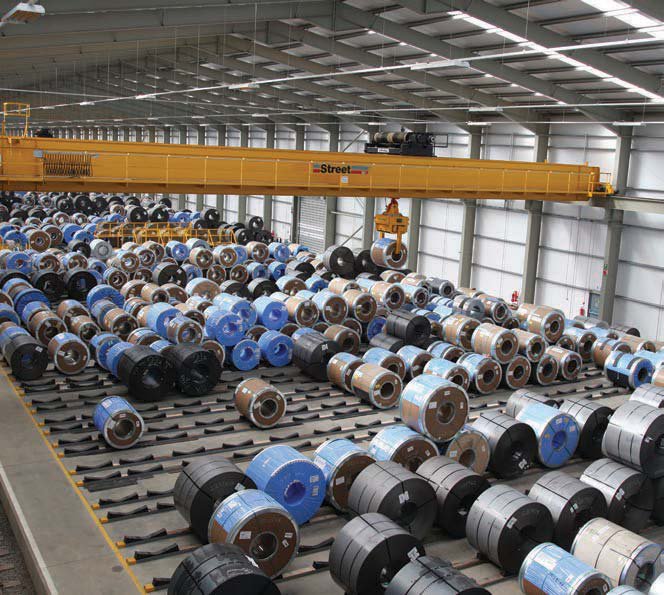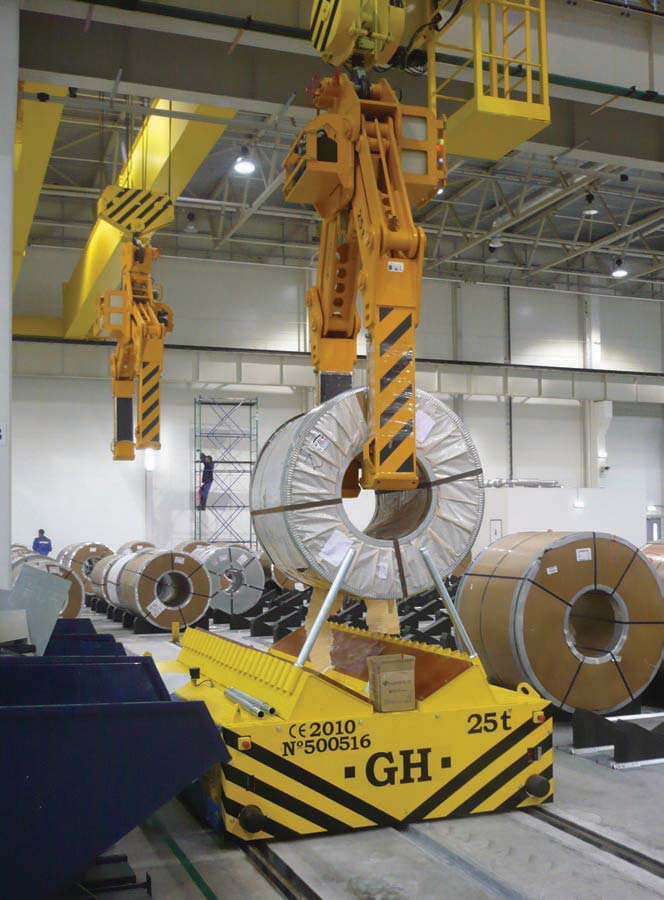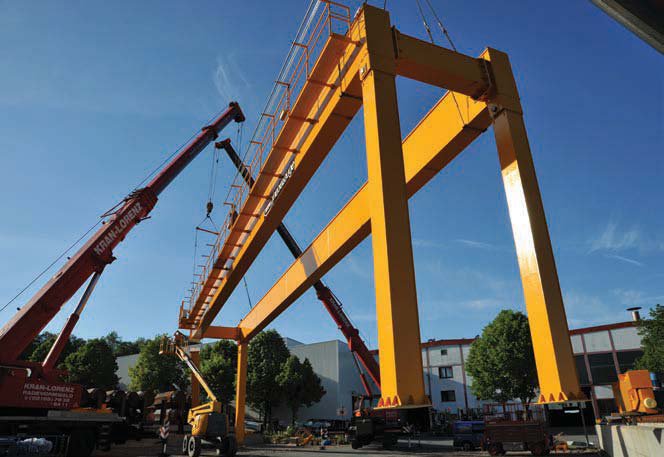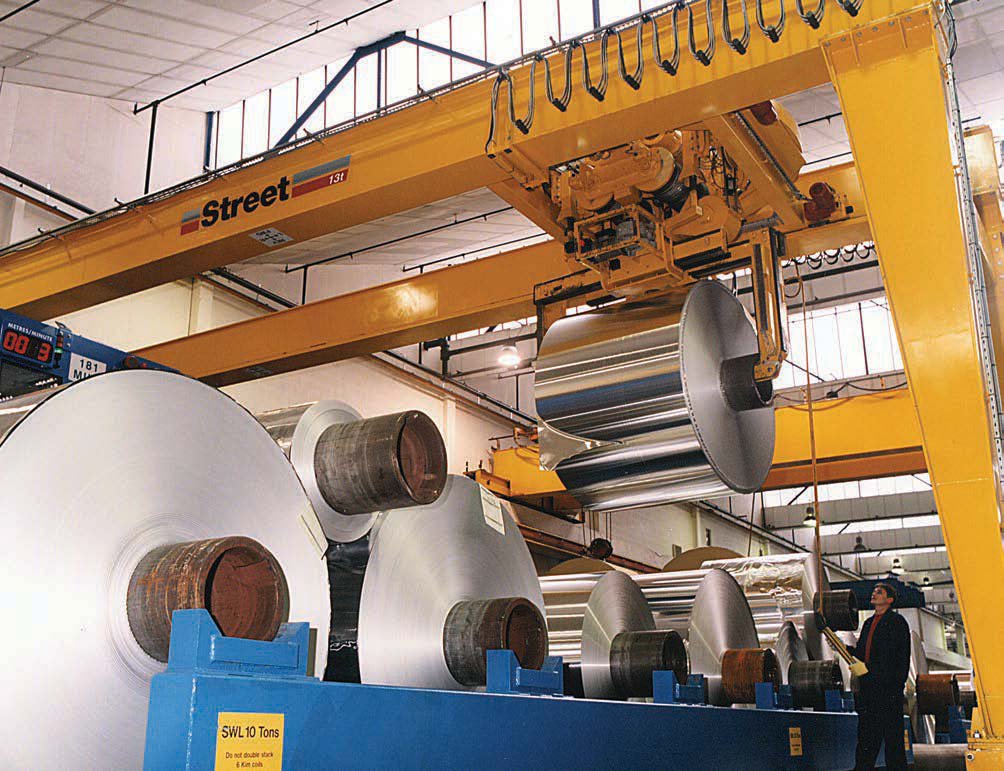Safety First
20 July 2018Manufacturers of cranes for the metals distribution sector are designing their technologies to provide greater levels of safety for operators, while offering improved data analysis about the type of lifts they undertake. Tom Woerndl reports.
Cranes and handling systems used in the metals distribution category have to be able to withstand the rigours of lifting extremely heavy materials, as well as the ebbs and flows of production which result in intense, peak periods of demand.
Steel and aluminium produced at industrial forges arrives at distribution centres in rolled and formed coils—often of several tonnes—which then have to be quickly processed and in many cases cut to size before being supplied to end users. As a result of the demands placed on lifting systems used in this industry, suppliers are increasingly offering equipment with enhanced safety features, plus the addition of monitoring tools that ensure operators can keep track of the safe working period (SWP) of their machines.
Andrew Pimblett, non-executive director of UK-based Street Crane, says customers are becoming more aware of the need to monitor how much of the design life or SWP of a crane has been used up, and how much remains.
“The metals industry is a challenging and intense environment for lifting equipment—often dealing with heavy loads and frequent lifts—and it’s useful for operators to have information about the duration and magnitude of the lifts a crane has made since installation, so that they can ensure they are not operating equipment beyond the intended design life,” says Pimblett.
Monitoring equipment from Street Crane informs users whether they are operating a crane within the SWP and therefore complying with UK industry regulations, including the Lifting Operations and Lifting Equipment Regulations (LOLER) and Provision and Use of Work Equipment Regulations (PUWER), as well as rigorous checks from the Health and Safety Executive (HSE).
“Thanks to the internet, we are now testing a new technology that can transmit information at an economic price from the SWP monitor on the crane to a variety of remote devices including a PC or a radio control handset,” adds Pimblett.
Headquartered in the Peak District, about 30km south-east of Manchester, Street manufacturers both full cranes and crane components with about three-quarters of its sales exported outside the UK. “We’ve had our best ever year,” explains Pimblett, who recently stepped down as managing director at the company, a position which he held since 1990. According to the company, remote control is another key demand from users in this sector, with Street Crane offering solutions through its Street Sabre product. The system is said to provide robust performance and safety compliance, protecting operator, equipment and load, while allowing up to 50 controllers to operate simultaneously in a single factory. “It’s rarely appropriate to use pendant control in a metals distribution environment, so the wireless option can give operators more flexibility and be more economical,” continues Pimblett. In this segment, Street Crane recently delivered five heavy-duty overhead cranes to increase capacity at Tata Steel’s Round Oak terminal in the West Midlands, UK, which can hold up to 60,000 tonnes of steel.
The £1 million investment is part of a major £6m revamp at the Round Oak site, which distributes steel to the automotive industry, steel stockholders and service centres throughout central England. Receiving 20 trainloads of steel a week from the Llanwern mill in Wales, steel must be rapidly offloaded and held in store until it is reloaded on to trucks for its final road journey.
The turnkey project from Street Crane included the removal of three existing cranes and installation of five new double girder overhead travelling cranes. Four of the new cranes are rated at 35t safe working load, and one at 42t.
The cranes all feature inverter control for smooth power take up and acceleration, while Street’s X-Y-Zero load stability system on all motions is designed to prevent load swing, assure safety and reduce loading cycles. Due to the high intensity usage, all mechanisms are rated heavy-duty M8 classification, adds Street Crane.
Brent Rozar, marketing and business development manager at US-based crane products and solutions supplier G.W. Becker, agrees that safety is one of the key current demands from customers in this industry.
“Safety and reliability have always been the lead in what our customers demand from our products,” he notes. “Automation, collision avoidance and scale systems are a few add on items that increase equipment operation safety.”
Although these are not strictly ‘new’ technologies, the company has recently developed other systems to improve safety, including hoist monitoring tools that track hours, lifts and faults; sway controls; and special below-the-hook devices for keeping the operator away from the load.
Recent installations in this segment include the completion of a multi-crane project with 25t coil handling cranes. “Each crane was built to CMAA Class E Standards,” continues Rozar.
“This turnkey project included the new custom built-up style overhead cranes, new runway rail, end stops, new runway electrification and self-performing installation.”
As well as asking for enhanced safety features, Rozar says that customers are additionally interested in free-standing runway systems for overhead cranes, which is the company’s “specialty”. “Several successful recent projects have included G.W. Becker designing, manufacturing and installing freestanding runway systems,” he notes.
Other keys benefits of equipment from G.W. Becker include the company’s flux vector control, which is specifically designed for a hoist without a mechanical load brake.
“The trolley hoist travel drives are designed with infinitely variable control and offer state of the art precision handling for extremely smooth operation and for minimal maintenance,” says Rozar.
As with Street Crane, the company is increasingly providing information for operators about crane status, faults and changeover parameters, positioning, and collision avoidance.
“Our overhead cranes have benefited companies by providing less product damage, improved product quality, reduced labour costs, more consistent moves and improved maintenance activities by providing predictive and preventive maintenance opportunities,” explains Rozar.
IMPROVING RELIABILITY
Dovetailing with operator safety, reliability is also seen as a crucial demand from the metals distribution sector.
“The reliability of the crane is extremely important for this industry,” explains David Comiono, vice president and general manager of EMH, which is based in Valley City, Ohio.
“Technology has to be designed for the peak use period during the day, which may often be three to four hours of intense production. Averages don’t really work in this sector!”
The US company offers pragmatic advice about the service life of its cranes for the industry, an area in which the company “is actively engaged”, says Comiono.
“We supply cranes to both the smalland large-scale ends of the market,” he adds. “Customers have different demands based on their previous experience of purchasing cranes for use in this sector, as well as how much money they’re willing to invest.” EMH has developed a line of standard hoists for applications in this category that are said to be easily serviced and feature variable frequency drives that bring a host of benefits.
“These drives are an industry standard for heavy hoisting applications,” adds Comiono. “They provide the horse power required to lift the load with less heat and no wastage of energy, which means the motors take less of a beating. In addition, the technology reduces brake maintenance by controlling the load electrically.”
Business in the sector has been positive recent months, says Comiono, with the company’s key markets the US and Germany, where EMH works with local partner Gloning.
“We recently had a significant order of a 30t crane for a coil handling company in the south-west of the US, with the customer set to install three more of our cranes at its facility,” says Comiono. Meanwhile, Juan Agirre, sales director at GH Cranes and Components—based in the north of Spain, about 80km southeast of Bilbao—notes that customers are increasingly looking for reliability, as well as robustness, high speeds, sway control, plus accurate load positioning and identification.
Projects GH been involved with in recent months include for steel manufacturer Acerinox, which was supplied with five cranes and a motorised hook to handle stainless steel coils with tong.
In addition, the company sold one automatic crane for handling steel sheets with an electromagnet to a steel service centre in northern Spain, as well as ten cranes for handling steel coils for the automotive industry for Gonvvama in China.
These cranes are rated at 35t with a 34m span, including double hoisting speed with a load alignment system designed to ensure vertical, anti-sway lifts.
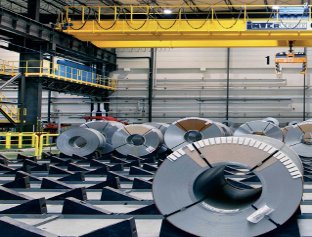 GH Cranes and Components, based in the north of Spain, says that customers are increasingly looking for reliability, robustness and high speeds
GH Cranes and Components, based in the north of Spain, says that customers are increasingly looking for reliability, robustness and high speeds
